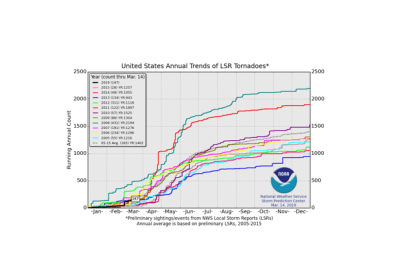
Tornado Risk Increase
There’s increasing evidence linking global warming to changes in the severe weather that gives rise to tornadoes. The thunderstorms that give rise to tornadoes occur to stabilize the atmosphere, and global warming can increase instability. Observational data shows there has been a subtle but detectable increase in tornado risk over the past few decades due to several factors including: a rise in the number of tornadoes in large tornado outbreaks, a shift in the time of year they occur, and changes in jet stream behavior that favor severe thunderstorms.
Read More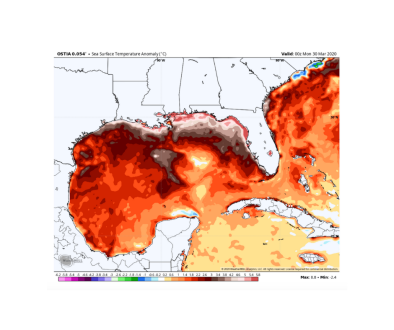
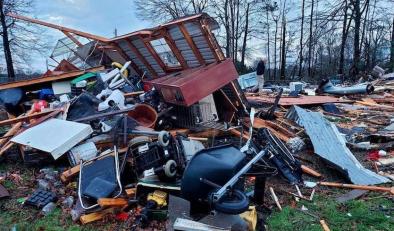
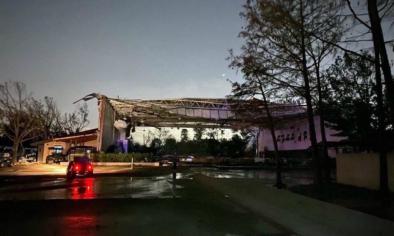
Climate science at a glance
-
The number of tornadoes in large tornado outbreaks is on the rise.[1][2]
-
The weather environments that produce severe storms are occurring more often.[3]
-
There has been an increase in the frequency of tornadoes in the Midwest and Southeast.[3][5]
-
Tornado seasonality is changing. Tornadoes are starting about a week earlier in the year in the tornado alley region from Nebraska to Texas,[4] and summer tornadoes are declining nationwide.
-
Tornado frequency is increasing in colder months between November and February, especially in the Southeast.[5] Nighttime tornadoes, which are 2.5 times as likely to cause fatalities, are more common during this time of year.[10]
-
Climate modeling of tornado activity is not robust enough to confidently determine future trends, though existing modeling projects a greater frequency of the severe weather conditions that might generate more or more severe tornadoes in the United States.
-
The 5 largest US winter tornado outbreaks on record have all hit since 1999.
-
The uncertainty about the climate change connection translates as an increase risk due to climate change.
Background information
How do tornadoes form?
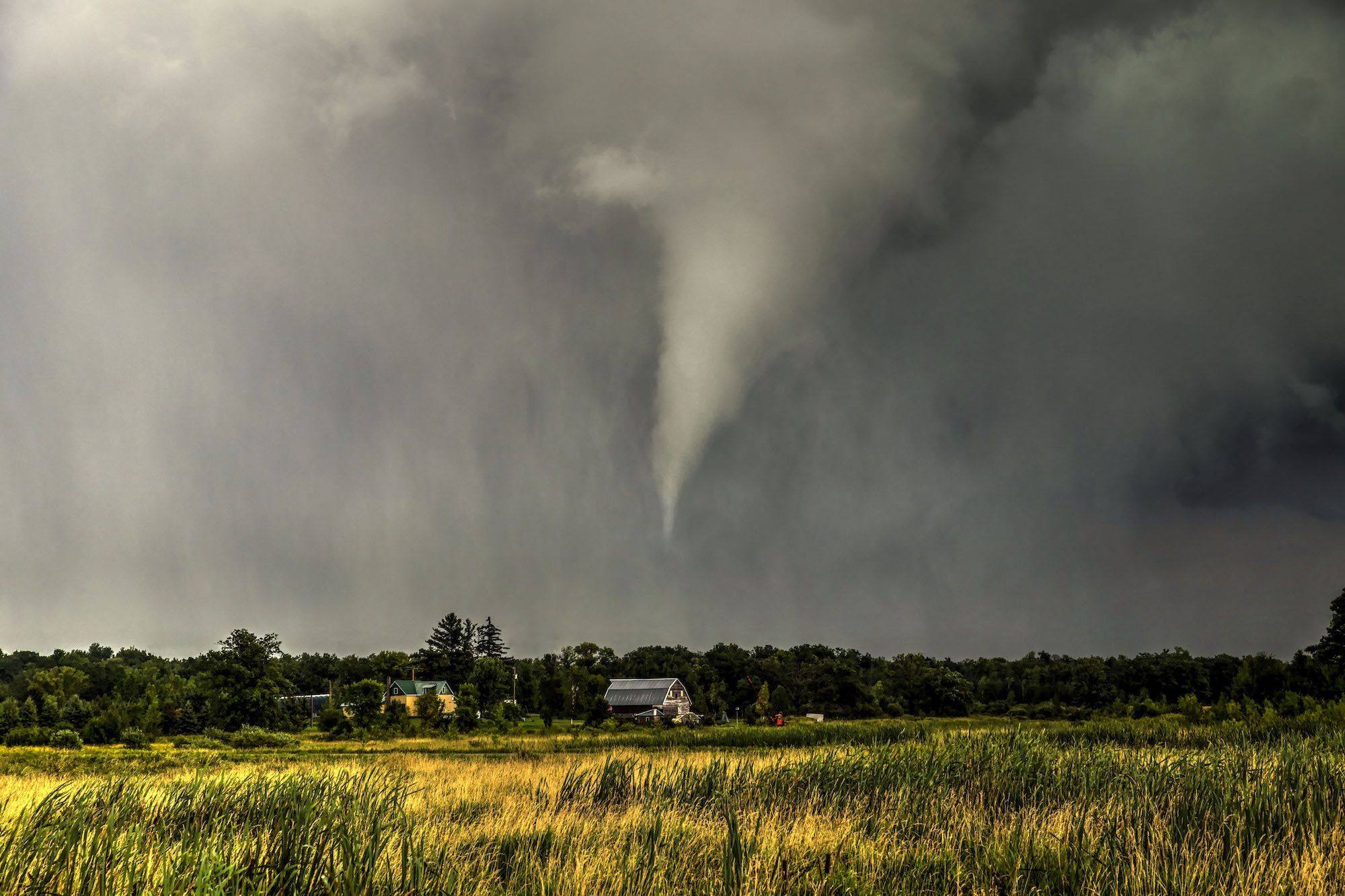 Tornadoes feed on warm, moist air from strong winds that change direction with altitude (known as wind shear).
Tornadoes feed on warm, moist air from strong winds that change direction with altitude (known as wind shear).
The mechanics of tornado generation is still not perfectly understood. The available weather reporting data on past tornado activity is limited and makes it difficult to identify whether there have been any long-term trends in tornado frequency, intensity or range.
How might climate change affect tornadoes?
Tornadoes tend to form under very specific atmospheric conditions — wind shear, or differences in wind speeds and direction; atmospheric instability; and moisture all fuel storms — and there are reasons to believe climate change is making those conditions more likely.
The rising levels of greenhouse gases in the air add more energy to the climate system. There’s less consensus on how climate change will affect wind shear, though a 2013 study on the thunderstorm conditions that form tornadoes found that the impact was negligible.[6]
How might changes in jet stream behavior due to climate change affect tornado activity?
The jet stream creates and steers individual storms and also sets up large-scale patterns. When the jet stream dips, creating a sharp trough, that is when you get the extreme upward motions of air that can cause severe thunderstorms, or even a tornado.[7]
What do the climate models show?
Until recently, climate modeling of tornado activity was not robust enough to confidently determine future trends. A 2023 study, however, used models at sufficiently small scales to predict a nationwide 6.6% increase in supercells and a 25.8% jump in the area and time the strongest supercells last by the end of the century.
Climate model projections indicate that convective available potential energy (CAPE)—a measure of the amount of energy available for convection—would increase in a warmer climate leading to more frequent environments favorable to severe thunderstorms in the United States.[6][8]
However, a December 2016 study links recent increases in the number of tornadoes per outbreak, not to CAPE, but to trends in storm relative helicity,[1] a quantity related to vertical wind shear previously identified as a factor in increased year-to-year variability of U.S. tornado numbers.[9]
US tornado trends
- (Ashley et al. 2023): Models predict a nationwide 6.6% increase in supercells and a 25.8% jump in the area and time the strongest supercells twist and tear over land under a scenario of moderate levels of future warming by the end of the century.
- (Moore et al, 2019) found that tornado activity is increasing throughout the Southeast and in the southern portion of the Midwest. Their research also shows tornadoes are also clustering on fewer days in the year, so that days with many tornadoes are becoming more common.[5]
- (Gensini and Brooks, 2018) found that over the past four decades, tornado frequency has increased over a large swath of the Midwest and Southeast and decreased in portions of the central and southern Great Plains, a region traditionally associated with Tornado Alley.[3]
- (Childs et al. 2018) found that the months of November to February are seeing an increase in average tornado activity, with a shift away from the Southern Plains and a ramp-up over the favored terrain of “Dixie Alley,” including Arkansas, Louisiana, Mississippi, Alabama, and Tennessee.[11] Nighttime tornadoes, which are more than twice as likely to cause fatalities, are more common during these colder months of the year.[10]
- (Agee and Larson, 2016) looked into what impact a warming trend over the U.S. in recent decades might have had on tornadoes, and found a new maximum center for tornadic storms emerging in the Deep South - the rise of the so-called "Dixie Alley."[12]
- (Tippett and Cohen, 2016) found that while the total number of tornadoes rated F/EF1 and higher each year hasn’t increased, the average number per outbreak has, rising from about 10 to about 15 since the 1950s.[13]
- (Trapp et al. 2009 and Diffenbaugh et al. 2013) consider climate model projections which show that convective available potential energy (CAPE)—a measure of the amount of energy available for convection—would increase in a warmer climate leading to more frequent environments favorable to severe thunderstorms in the United States.[6][8]
Quotes
We can’t take one tornado and say, 'yep, climate change did it,' but we can certainly point to factors related to climate change and say unusual weather is happening more often. These kinds of things are gonna happen more often.[7]
Jennifer Francis, Woods Hole Research Center atmospheric scientist
Changes in tornado activity could be caused by global warming, but our usual tools, the observational record and computer models, are not up to the task of answering this question yet.
The simplest change to understand is a shift of the entire distribution, but increases in variability are possible as well. With tornadoes, we’re seeing both of those mechanisms at play.[14]
Michael Tippett, Columbia University professor of applied mathematics
Tornadoes are the kind of extreme event where we have the least confidence in our ability to attribute the odds or characteristics of individual events to an influence of global warming.
We do have strong evidence that at the large scale global warming is likely to increase the atmospheric environments that create the kind of severe thunderstorm that produces tornadoes.[15]
Noah Diffenbaugh, Stanford University professor of earth system science

